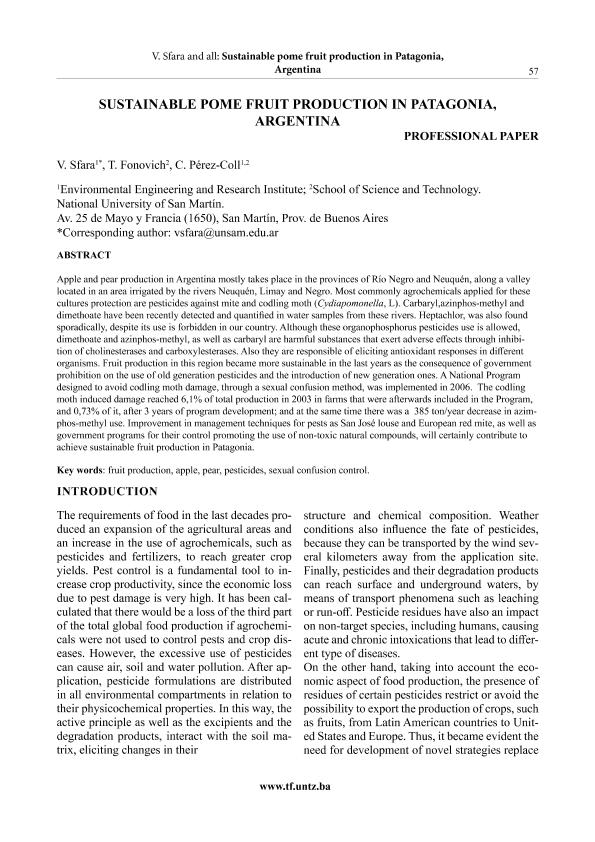Mostrar el registro sencillo del ítem
dc.contributor.author
Sfara, Valeria

dc.contributor.author
Fonovich, Teresa Mabel

dc.contributor.author
Perez Coll, Cristina Silvia

dc.date.available
2022-12-01T14:06:52Z
dc.date.issued
2016-12
dc.identifier.citation
Sfara, Valeria; Fonovich, Teresa Mabel; Perez Coll, Cristina Silvia; Sustainable pome fruit production in Patagonia, Argentina; University of Tuzla; Technologica Acta; 9; 2; 12-2016; 57-61
dc.identifier.issn
1840-0426
dc.identifier.uri
http://hdl.handle.net/11336/179780
dc.description.abstract
Apple and pear production in Argentina mostly takes place in the provinces of Río Negro and Neuquén, along a valley located in an area irrigated by the rivers Neuquén, Limay and Negro. Most commonly agrochemicals applied for these cultures protection are pesticides against mite and codling moth (Cydiapomonella, L). Carbaryl,azinphos-methyl and dimethoate have been recently detected and quantified in water samples from these rivers. Heptachlor, was also found sporadically, despite its use is forbidden in our country. Although these organophosphorus pesticides use is allowed, dimethoate and azinphos-methyl, as well as carbaryl are harmful substances that exert adverse effects through inhibition of cholinesterases and carboxylesterases. Also they are responsible of eliciting antioxidant responses in different organisms. Fruit production in this region became more sustainable in the last years as the consequence of government prohibition on the use of old generation pesticides and the introduction of new generation ones. A National Program designed to avoid codling moth damage, through a sexual confusion method, was implemented in 2006. The codling moth induced damage reached 6,1% of total production in 2003 in farms that were afterwards included in the Program, and 0,73% of it, after 3 years of program development; and at the same time there was a 385 ton/year decrease in azimphos-methyl use. Improvement in management techniques for pests as San José louse and European red mite, as well as government programs for their control promoting the use of non-toxic natural compounds, will certainly contribute to achieve sustainable fruit production in Patagonia.
dc.format
application/pdf
dc.language.iso
eng
dc.publisher
University of Tuzla
dc.rights
info:eu-repo/semantics/openAccess
dc.rights.uri
https://creativecommons.org/licenses/by/2.5/ar/
dc.subject
SUSTAINABLE MANAGEMENT
dc.subject
FRUIT PRODUCTION
dc.subject
PATAGONIA
dc.subject.classification
Ciencias Medioambientales

dc.subject.classification
Ciencias de la Tierra y relacionadas con el Medio Ambiente

dc.subject.classification
CIENCIAS NATURALES Y EXACTAS

dc.title
Sustainable pome fruit production in Patagonia, Argentina
dc.type
info:eu-repo/semantics/article
dc.type
info:ar-repo/semantics/artículo
dc.type
info:eu-repo/semantics/publishedVersion
dc.date.updated
2022-11-25T12:07:52Z
dc.identifier.eissn
2232-7568
dc.journal.volume
9
dc.journal.number
2
dc.journal.pagination
57-61
dc.journal.pais
Bosnia y Herzegovina

dc.journal.ciudad
Tuzla
dc.description.fil
Fil: Sfara, Valeria. Consejo Nacional de Investigaciones Científicas y Técnicas; Argentina. Universidad Nacional de San Martín. Instituto de Investigación en Ingeniería Ambiental; Argentina
dc.description.fil
Fil: Fonovich, Teresa Mabel. Universidad Nacional de San Martín. Instituto de Investigación en Ingeniería Ambiental; Argentina
dc.description.fil
Fil: Perez Coll, Cristina Silvia. Consejo Nacional de Investigaciones Científicas y Técnicas; Argentina. Universidad Nacional de San Martín. Instituto de Investigación en Ingeniería Ambiental; Argentina
dc.journal.title
Technologica Acta
dc.relation.alternativeid
info:eu-repo/semantics/altIdentifier/url/https://hrcak.srce.hr/ojs/index.php/technologicaacta/issue/view/662
Archivos asociados
